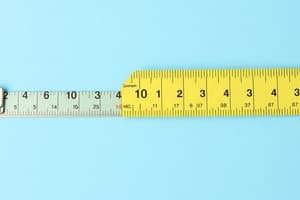Podcast
Questions and Answers
One meter is equivalent to 100 centimeters.
One meter is equivalent to 100 centimeters.
True (A)
In the English system, 1 foot is equal to 12 inches.
In the English system, 1 foot is equal to 12 inches.
True (A)
To convert inches to centimeters, you multiply by 2.54.
To convert inches to centimeters, you multiply by 2.54.
True (A)
The smallest graduation on a yardstick is 1/8 inch.
The smallest graduation on a yardstick is 1/8 inch.
One yard is equivalent to 36 inches.
One yard is equivalent to 36 inches.
In the metric system, 1 centimeter is equal to 10 millimeters.
In the metric system, 1 centimeter is equal to 10 millimeters.
To convert feet to meters, you should multiply the number of feet by 3.28.
To convert feet to meters, you should multiply the number of feet by 3.28.
60 centimeters is equal to 23.62 inches.
60 centimeters is equal to 23.62 inches.
The English system of measurement originated in France.
The English system of measurement originated in France.
The Metric system is also known as Systems International (S.I).
The Metric system is also known as Systems International (S.I).
Inaccurate measurements can lead to waste of time and materials.
Inaccurate measurements can lead to waste of time and materials.
The Metric system is primarily based on units of 12.
The Metric system is primarily based on units of 12.
Reading measurements accurately is a crucial skill in trade mathematics.
Reading measurements accurately is a crucial skill in trade mathematics.
The English system includes unit conversions based on factors of 10.
The English system includes unit conversions based on factors of 10.
Two systems of measurement discussed are the English system and the Metric system.
Two systems of measurement discussed are the English system and the Metric system.
Trade mathematics only involves theoretical measurements with no practical application.
Trade mathematics only involves theoretical measurements with no practical application.
The English system of measurement originated in France.
The English system of measurement originated in France.
The Metric system is also known as Systems International (S.I).
The Metric system is also known as Systems International (S.I).
Conversions between measurement systems are inherently straightforward with no complications.
Conversions between measurement systems are inherently straightforward with no complications.
The English system includes units such as inches, feet, and pounds.
The English system includes units such as inches, feet, and pounds.
Kilometers and grams are units found in the English measurement system.
Kilometers and grams are units found in the English measurement system.
There are no units for volume in the Metric system.
There are no units for volume in the Metric system.
Fahrenheit is a unit of temperature commonly used in the Metric system.
Fahrenheit is a unit of temperature commonly used in the Metric system.
The process of converting between the English and Metric systems can involve multiplying or dividing by conversion factors.
The process of converting between the English and Metric systems can involve multiplying or dividing by conversion factors.
Flashcards are hidden until you start studying
Study Notes
Measurement Systems
- There are two primary measurement systems: the English system (originating in England) and the Metric system, also known as the Systems International (S.I), which originated in France.
- The English system involves units like inches, feet, and yards.
- The Metric system utilizes meters, centimeters, and millimeters.
Basic Units
- Meter (m): The fundamental unit in the Systems International.
- Centimeter (cm): One-hundredth of a meter.
- Millimeter (mm): One-tenth of a centimeter.
- Inch (in): Divided into sixteen graduations, with the smallest graduation being 1/16.
Conversions
- Metric to English:
- 1 inch = 0.0254 meters
- 1 inch = 2.54 centimeters
- 1 foot = 0.3048 meters
- 1 yard = 0.9144 meters
- English to Metric:
- 1 meter = 39.37 inches
- 1 meter = 3.28 feet
Essential Skills
- Accuracy: Accurate measurement is crucial to avoid waste of time, effort, and materials.
- Reading Measurements: The ability to interpret measurement markings is essential for constructing objects.
Fundamental Math Operations
- Addition
- Subtraction
- Multiplication: This operation combines quantities to obtain a product.
- Factors: Numbers multiplied together.
- Product: The result of multiplication.
- Division: This operation determines how many times one quantity is contained within another.
- Dividend: The number being divided.
- Divisor: The number dividing the dividend.
- Quotient: The result of division.
- Remainder: The left-over part after division.
Importance of Understanding
- Understanding measurement systems and essential math operations is fundamental for successful construction and engineering tasks.
Studying That Suits You
Use AI to generate personalized quizzes and flashcards to suit your learning preferences.




